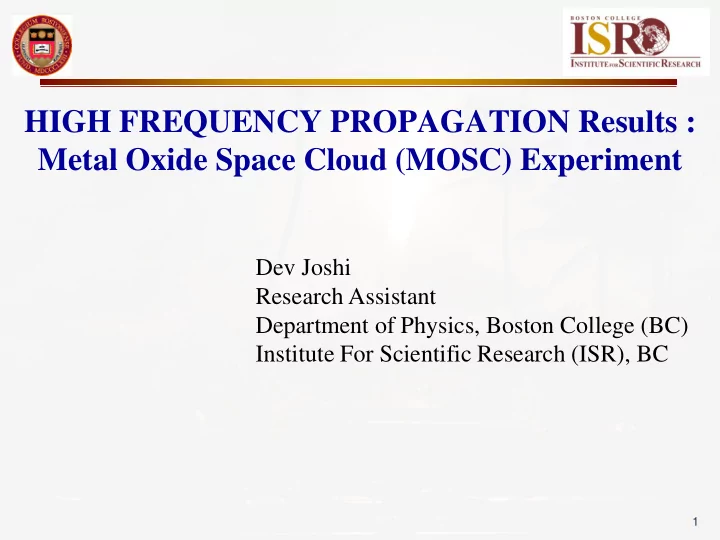

HIGH FREQUENCY PROPAGATION Results : Metal Oxide Space Cloud (MOSC) Experiment Dev Joshi Research Assistant Department of Physics, Boston College (BC) Institute For Scientific Research (ISR), BC 1
Joshi, Dev 1 ; Groves, Keith 1 ; McNeil, William 1 ; Caton,Ronald 2 ; Parris., R. Todd 2 ; Pederson,Todd 2 ; Cannon,Paul 3 ; Angling,Matthew 3 ; Jackson-Booth, Natasha 4 1. Institute for Scientific Research, Boston College, MA USA 2. U.S. Air Force Research Laboratory, NM USA 3. University of Birmingham, UK 4. QinetiQ,UK. 2
HF PROPAGATION Results : Metal Oxide Space Cloud Experiment Rocket Ionosphere Metal Vapor Release ALTAIR Incoherent HF Tx HF Rx Scatter RADAR 3
Outline : • Introduction • Observations • Modeling Results • Conclusions 4
Transmitter/Receiver Geometry N E Rongelap MOSC Release Location & Likiep-Wotho Mid-Point Wotho Likiep ALTAIR Kwajalein • Rongelap-Wotho link geometry is predominantly N-S and great-circle path is far from release region • Likiep-Wotho path is nearly E-W and release point lies nearly on mid-point of the link—should be ideal for observing SmO+ layer 5
Two Releases : 01 May and 09 May 2013 • Ionosphere during first release was disturbed, rising rapidly and Spread F formed within minutes after release • Ionosphere during second release is canonical quiescent 6
Mission 41102 09 May 2013 Pre-Release Sweep Wotho Receiver Likiep TX Rongelap TX F –region second hop F -region Ground Wave • Sweeps from 2-30 MHz were completed every five (5) minutes - Plots show data from only 2-14 MHz since no signatures were observed at higher frequencies • Slightly higher peak frequencies on Wotho Likiep path relative to Rongelap-Wotho links probably due to longer path length, lower elevation angle propagation . 7
Mission 41102 09 May 2013 1 st Post-Release Sweep Wotho Receiver Rongelap TX Likiep TX F-layer Secondary Echo F -region Ground Wave MOSC layer MOSC layer • On the Wotho geometry the layer extends up to 10 MHz peak frequency • There is also a prominent secondary F region echo; the time delays will allow us to calculate the range offsets • The discrete nature of the echo suggests a localized perturbation that extends up to the F- region peak 8
MOSC Launch 2: May 9, 2013 Modeling the Cloud The averaged and symmetrized cloud profile is used to model the cloud in MATLAB with latitude/longitude increment at 0.0141degree and height increment at 1.5510 km . The central pixel corresponds to 7.4369 MHz 9
3D Ray Trace Analysis Rongelap To Wotho Rongelap MOSC Release Point Wotho • HF signals received well off the great circle path to the receiver • The artificial cloud bends the HF energy through large angles • Excellent agreement between model and observations 10
3D Ray Trace Analysis Likiep To Wotho Wotho MOSC Release Point Likiep MOSC • Great circle path to the receiver passes through the MOSC volume • Multiple paths between ionosphere, cloud and receiver expected Likiep Wotho 11
Mission 41100 01 May 2013 1 st Post-Release Sweep Wotho Receiver Likiep TX Rongelap TX F-layer Secondary Echo MOSC layer MOSC layer • Note that the Likiep signature is only evident in high end of frequency range, showing up near f = 8 MHz (~07:42 UT); one might conclude this is results from the temporal evolution of the cloud, yet the Rongelap link shows the signature beginning at less than 4 MHz at least 40 seconds earlier. • One possibility is that the lower frequency components on the direct Likiep-Wotho link were actually blocked, refracted or ducted by the presence of the MOSC cloud. 12
Modeling : Optimization Method Optimization : Nalder Mead Down Hill Simplex Method ( Amoeba)* • Nelder, J. and R. Mead ,1965 • Direct Method : No derivatives, only function values • Idea : Move from high function (hot) areas to low function (cold) areas by reflections, expansions and contractions • “Amoeba Crawls Downhill with no assumption about function” • Built-in function in MATLAB : fminsearch *Minimization Technique suggested by Dr. Charles Carrano, ISR 13
Optimization : Model Ionosphere PIM doesn’t have enough degrees of freedom to fit the ALTAIR radar profile while optimization of foF2 and hoF2 in IRI closely matches the observed ALTAIR radar profile. Scale Vector = [ a b c …. e] 14
Optimization : Delay results • Optimization of the scaling vector matches only the upside • Frequency specific optimization of the scale vector exactly reproduces the observed delay. 15
Conclusions • Ray tracing confirms sounder observations to high degree of fidelity • The change in ambient natural propagation environment due to small artificial modification can be successfully modeled • Effects from arbitrary artificial plasma environments can be predicted with accuracy • Optimization technique represents a new method of assimilating oblique ionosonde data to generate the background ionosphere (numerous applications for HF systems) • Future Work : Modeling of natural disturbances in the low latitude propagation environment to understand the effects of Traveling Ionospheric Disturbances (TIDs) and Spread F on perpendicular and quasi-parallel (to B ) paths. 16
Recommend
More recommend